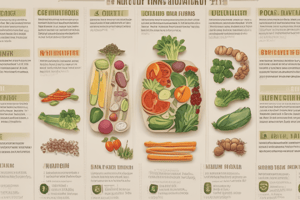Podcast
Questions and Answers
What is the main purpose of the multi-mix principle?
What is the main purpose of the multi-mix principle?
- To promote different cooking methods
- To reduce food waste
- To ensure variety in meals
- To complement each other for adequate nutrient intake (correct)
Which of the following is an example of a two-mix meal?
Which of the following is an example of a two-mix meal?
- Rice and peas with glazed carrots
- Ripe plantain with salt fish and callaloo
- Boiled yam and stewed beans
- Bread and peanut butter (correct)
Which combination represents a three-mix meal?
Which combination represents a three-mix meal?
- Ripe plantain with salt fish and callaloo (correct)
- Rice and stewed lentils
- Boiled yam, stewed beans, oxtail, and pumpkin
- Boiled dumplings, stewed beef, broad beans, and carrots
What constitutes a four-mix meal?
What constitutes a four-mix meal?
Which of the following nutrients is NOT part of the reference standards used to calculate % Daily Values?
Which of the following nutrients is NOT part of the reference standards used to calculate % Daily Values?
How is the % Daily Value calculated for a nutrient?
How is the % Daily Value calculated for a nutrient?
What is the recommended daily intake (RDI) primarily concerned with?
What is the recommended daily intake (RDI) primarily concerned with?
Which of the following pairs of foods exemplifies a two-mix?
Which of the following pairs of foods exemplifies a two-mix?
What does the EAR represent in dietary recommendations?
What does the EAR represent in dietary recommendations?
Which statement accurately describes the RDA?
Which statement accurately describes the RDA?
What is the purpose of the AI in dietary guidelines?
What is the purpose of the AI in dietary guidelines?
What does the UL indicate about nutrient intake?
What does the UL indicate about nutrient intake?
How is the RDA established based on the EAR?
How is the RDA established based on the EAR?
What does a deficiency in nutrient intake indicate?
What does a deficiency in nutrient intake indicate?
Which of the following is true about nutrient intake distribution?
Which of the following is true about nutrient intake distribution?
When can the AI be used in dietary recommendations?
When can the AI be used in dietary recommendations?
Which measurement is used in anthropometry for assessing body size and composition?
Which measurement is used in anthropometry for assessing body size and composition?
What does the BMI equation represent?
What does the BMI equation represent?
Which of the following is NOT a method of individual assessment?
Which of the following is NOT a method of individual assessment?
What is bioelectrical impedance (BIA) used to measure?
What is bioelectrical impedance (BIA) used to measure?
Which of the following represents a common index used in anthropometry?
Which of the following represents a common index used in anthropometry?
Which method of dietary assessment involves tracking food intake over a specific period?
Which method of dietary assessment involves tracking food intake over a specific period?
In the context of nutritional health assessment, what is the primary purpose of collecting historical information?
In the context of nutritional health assessment, what is the primary purpose of collecting historical information?
The waist-to-hip ratio is primarily used to assess which aspect of nutritional health?
The waist-to-hip ratio is primarily used to assess which aspect of nutritional health?
Which food group is recommended to be reduced in daily intake?
Which food group is recommended to be reduced in daily intake?
What is one of the key messages regarding daily meals?
What is one of the key messages regarding daily meals?
Which of the following food groups is classified as containing carbohydrates including fiber?
Which of the following food groups is classified as containing carbohydrates including fiber?
Which nutrients are primarily found in the 'Food From Animals' group?
Which nutrients are primarily found in the 'Food From Animals' group?
Which nutrient is NOT typically associated with vegetables?
Which nutrient is NOT typically associated with vegetables?
What is promoted alongside the consumption of a balanced diet?
What is promoted alongside the consumption of a balanced diet?
Which food group is NOT considered a foundation group in meal building?
Which food group is NOT considered a foundation group in meal building?
What is a significant source of minerals like iron and calcium?
What is a significant source of minerals like iron and calcium?
Which vitamin is found in fats and oils?
Which vitamin is found in fats and oils?
What is recommended regarding the consumption of processed foods?
What is recommended regarding the consumption of processed foods?
What does RDA stand for and what percentage of healthy people does it aim to meet?
What does RDA stand for and what percentage of healthy people does it aim to meet?
What are Acceptable Macronutrient Distribution Ranges (AMDRs) designed to achieve?
What are Acceptable Macronutrient Distribution Ranges (AMDRs) designed to achieve?
Which principle is NOT part of the diet-planning principles for a healthy diet?
Which principle is NOT part of the diet-planning principles for a healthy diet?
What are the intended uses of nutrient standards?
What are the intended uses of nutrient standards?
What does the food guide for Jamaicans emphasize in healthy eating?
What does the food guide for Jamaicans emphasize in healthy eating?
Which nutrient standard is commonly used to evaluate individual diets?
Which nutrient standard is commonly used to evaluate individual diets?
What role do dietary guidelines play in food labeling?
What role do dietary guidelines play in food labeling?
Which of the following is NOT considered to contribute to a healthy diet?
Which of the following is NOT considered to contribute to a healthy diet?
Flashcards
EAR
EAR
Estimated Average Requirement; daily amount of nutrient needed by 50% of healthy individuals in a specific group.
RDA
RDA
Recommended Dietary Allowance; daily intake needed to meet the requirements of ~98% of healthy individuals.
AI
AI
Adequate Intake; dietary recommendation when insufficient data exists to set an RDA.
UL
UL
Signup and view all the flashcards
AMDR
AMDR
Signup and view all the flashcards
24-hour recall
24-hour recall
Signup and view all the flashcards
Food diary
Food diary
Signup and view all the flashcards
Food Frequency Questionnaire
Food Frequency Questionnaire
Signup and view all the flashcards
Diet History
Diet History
Signup and view all the flashcards
Anthropometry
Anthropometry
Signup and view all the flashcards
BMI
BMI
Signup and view all the flashcards
calorie
calorie
Signup and view all the flashcards
margin of safety
margin of safety
Signup and view all the flashcards
Multi-mix principle
Multi-mix principle
Signup and view all the flashcards
Two-mix
Two-mix
Signup and view all the flashcards
Three-mix
Three-mix
Signup and view all the flashcards
Four-mix
Four-mix
Signup and view all the flashcards
% Daily Value (%DV)
% Daily Value (%DV)
Signup and view all the flashcards
Nutritional Health Assessment
Nutritional Health Assessment
Signup and view all the flashcards
Historical Information (diet & health)
Historical Information (diet & health)
Signup and view all the flashcards
Study Notes
Dietary Reference Intakes (DRIs)
- EAR (Estimated Average Requirement): Represents the daily amount of a nutrient needed to meet the requirements of 50% of healthy individuals in a specific life stage or sex group.
- RDA (Recommended Dietary Allowance): Provides the recommended daily intake of various nutrients that fulfill the nutritional needs of approximately 98% of healthy individuals.
- AI (Adequate Intake): Dietary recommendations used when there's insufficient scientific data to establish an RDA.
- UL (Tolerable Upper Intake Level [Upper Level]): Defines the highest daily average intake of a nutrient that's considered unlikely to cause adverse health effects.
Establishing RDAs
- A "margin of safety" is added to the EAR to account for individual variation in nutrient needs.
- The RDA is high enough to meet or exceed the needs of 97-98% of healthy individuals.
Applying Nutrient Standards
- DRIs are used to:
- Plan nutritious diets for groups of people.
- Evaluate the nutritional adequacy of a population's diet.
- Develop specific food products.
- Provide standards for nutritional labeling (Daily Values).
Acceptable Macronutrient Distribution Ranges (AMDRs)
- AMDRs provide nutritionally adequate ranges for macronutrient (fat, carbohydrate, protein) intake, aiming to reduce the risk of diet-related chronic diseases.
Dietary Guidelines for Jamaica
- Food guide: A plate depicting the recommended proportions of six food groups for healthy eating. It encourages variety, adequacy, balance, and control.
- Food groups:
- Staples (corn, tubers, rice, plantain)
- Vegetables
- Fruits
- Fats and Oils (including avocado and coconut)
- Animal-source foods (fish, meat, eggs, dairy products)
- Legumes and nuts.
- Recommendations:
- Eat a variety of foods from all food groups daily.
- Increase intake of fruits and vegetables daily.
- Include peas, beans, and nuts in daily meals.
- Reduce intake of salty, processed, and sugary foods and drinks.
- Engage in physical activity routinely.
Dietary Guidelines for Barbados
- The specific details of these guidelines are not mentioned in the provided text.
Six Food Groups for the Caribbean
- Staples: Provide carbohydrates, fiber, protein, B complex vitamins, and minerals.
- Legumes: Supply carbohydrates, fiber, protein, minerals (iron, calcium), B complex vitamins, and vitamin E.
- Food from Animals: Offer protein, fats, vitamins, and calcium.
- Fruits: Contain carbohydrates, fiber, water-soluble vitamins, and minerals (potassium).
- Vegetables: Provide carbohydrates, fiber, B complex vitamins, vitamin C, and minerals (iron, calcium).
- Fats and Oils: Contribute fats and vitamins A and E.
Building a Balanced Caribbean Meal
- Multi-mix principle: Combining different food groups to ensure an adequate intake of essential nutrients.
- Types of multi-mixes:
- Two-mix: The simplest and most affordable combination, pairing staples with either legumes or animal protein for a complete protein.
- Three-mix: Adding non-starchy vegetables to a two-mix.
- Four-mix: Includes all four foundation food groups (staples, legumes, animal foods, and vegetables) in one meal, often found in one-pot dishes.
% Daily Value (%DV)
- The %DV is calculated by dividing the amount of a nutrient in a serving by its daily value and multiplying by 100.
Assessing Nutritional Health
- The first step in planning and evaluating nutritional care for individuals or groups.
- Determined through multiple sources of information.
- Involves a systematic method of obtaining, verifying, and interpreting nutrition information.
Individual Assessment
- Utilizes various methods to collect data and create a complete picture of an individual's nutritional status:
- Historical Information (Diet & Health):
- 24-hour recall: A record of all foods and beverages consumed in a 24-hour period.
- Food Diary or Food Intake Record: Detailed documentation of food intake over a specific period.
- Food Frequency Questionnaire: Assess the frequency of consumption for various food groups.
- Diet History: A comprehensive overview of dietary habits.
- Anthropometric Measurements: Measurements of the body, such as weight, height, body mass index (BMI), and circumferences.
- Physical Examinations: Assessment of physical characteristics related to nutrition.
- Laboratory Tests: Blood tests or other laboratory analyses to evaluate nutritional status.
- Historical Information (Diet & Health):
Anthropometry
- The study of measuring the human body in terms of bone, muscle, and adipose tissue dimensions.
- Measurements include:
- Weight: A measure of body mass.
- Height/Length: A measure of stature.
- Circumferences: Measurements of specific body parts (e.g., waist, hip, arm).
- Bioelectrical Impedance (BIA): A method that measures electrical resistance to assess body composition.
Common Anthropometry Indices
- BMI (Body Mass Index): Calculated by dividing weight (kg) by height squared (m²).
- Waist-To-Hip Ratio (WHR): A measure of fat distribution.
- Mid-upper Arm Circumference: Indicates muscle and fat mass in the arm.
- Waist-To-Height Ratio (WHTR): A measure of abdominal fat.
Diet Assessment Methods
- 24-Hour Recall: Records everything consumed in a 24-hour period.
- Food Diary or Food Intake Record: Detailed food intake documentation over a specific time.
- Food Frequency Questionnaire: Asks the frequency of consumption of certain food groups.
- Diet History: Comprehensive overview of dietary habits.
Studying That Suits You
Use AI to generate personalized quizzes and flashcards to suit your learning preferences.




